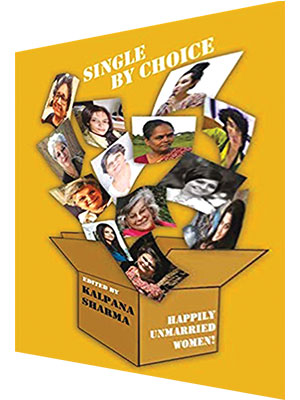 Single by choice: Happily unmarried women – Kalpana Sharma
Single by choice: Happily unmarried women – Kalpana Sharma
Women Limited; Rs.275; Pages 145
To be single by choice is not seen as choice. A few women I knew were kept single by their fathers so that the salary they brought home could provide for the son’s education. Others were promoted to the status of sons providing for siblings’ marriages and the welfare of their parents first with pride, then confusion and later resignation.
Some of these women married late in life, found husbands who valued them and provided the tender care and respect that fall through a gap in parental homes. I remember admiring one scientist who is single until she said in a matter-of-fact tone that may be single women are those not lucky enough to find the right partner. I remember I was shocked at the clay feet of my idol.
On the other hand, for many women marriage is also an escape from parental homes which are often not as ideal as they are made out to be. I also remember arguing at one point that ideally a woman should, like Draupadi, have five husbands — one to read and argue with, one to travel with, one to raise children and mind parents with, one to dream and star gaze with and one just to go to bed with!
To be single by choice is a luxury and also a question of class, even if the precise moment of choice seems hazy. But to have a family that respects your work, your will and your capacity to stand on your own feet is a great thing. In this very interesting book, Kalpana Sharma has put together a rich collection of extraordinary women who speak of their journeys and choices so casually, that it’s breathtaking.
This compendium highlights that supportive parents and a rewarding professional life provide the social capital that independent women need. The title puts paid to the vulgar jokes that groups of lusty single men ‘bachelors’ et al shower on ‘old maids’ picking at their grey hair and warts waiting listlessly for a man to appear on their bleak horizon. The reflection that such a question raises is priceless.
Sharma points out that the book is not a sociological survey but told from a perspective of single women raising questions about the institution of marriage, patriarchy, subservience, independence and equality.
After writing about single women, all remarkable, all famous, who had survived the loss of long-time partners and continued to build the rest of their lives brick by brick burying their grief and transforming their world, reading this collection was in a sense like walking through the looking glass, and again perhaps not. The assumptions made about single women’s needs, unmarried or widowed, have a striking similarity unless there is strong family support.
To marry, or not to marry, that’s the question. Whether to take arms against the sea of family and struggle with its endless demands and survive as a human being, or to turn away and swim against the tide to live a life that’s empowering and fulfilling. This book shows that work well done, having a family and community extending beyond the traditional, can be deeply satisfying. Each of the women in this volume are remarkable achievers integrated with the communities they work with while enjoying the independence of being single.
Social worker Laila Tyabji points out that as the compromises and adjustments of marriage became increasingly claustrophobic, the idea of a lover who lived down the lane seemed bliss. She highlights that while stereotypes change, the fondness for stereotypes does not. So a single liberated girl must be wildly promiscuous. And while she baulked at the thought of single motherhood, she found a daughter late in life and enjoyed the joy of motherhood.
Writer-teacher Bama Faustine Soosairaj’s account is poignant and honest as she traces her painful journey into a convent and out of it, finally focusing on teaching as the most productive thing she can do while she pounds out powerful novels that capture the life of a woman who is Dalit, single and stubborn, in graphic detail. It also reminds us how inviting and safe a nunnery seems from the outside. The single woman was always an object to be exploited and abused by family and community until feminism actually realised this was a category to focus on.
Socialist Sujatha Patel painstakingly analyses the choices and hazards of the single professional. She takes apart each aspect, laying bare the public attitudes and prejudices about single women who are successful.
Researcher and consultant Asmita Basu highlights that the domesticity of relationships forges similar patterns. The single woman poses a threat to ordered patriarchy. And that aloneness and singleness are not matter of choice. And just as there is more to marriage than companionship, there is more to singleness than being alone. That’s a nugget to store.
Scientist Vineeta Bal points out that without a clear understanding of gender politics, it is impossible to think seriously about change. She says it’s rare to find a never married scientist in science conventions, and many who were married stayed home and lost out on a career.
One of the most delightful essays in this book is by journalist Aheli Moitra. The warmth, humour and clarity of this essay has to be enjoyed first hand.
On the whole, this is a readable and insightful book. Kalpana Sharma has an eye for social trends and has created a category of radical women who have chosen their own new way of life.
Vasanth Kannabiran (The Book Review, January)

























